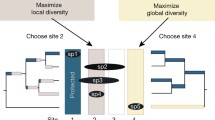Abstract
As conservation biology has developed as a distinct discipline from ecology, conservation guidelines based on ecological theory have been largely cast aside in favor of theory-independent decision procedures for designing conservation reserves. I argue that this transition has failed to advance the field toward its aim of preserving biodiversity. The abandonment of island biogeography theory in favor of complementarity-based algorithms is a case in point. In what follows, I consider the four central objections raised against island biogeographic conservation guidelines, arguing that they fail to undermine the credibility of this framework as a conservation tool. At best, these objections call for a more careful application of this framework to conservation problems, not its wholesale abandonment. At the same time, complementarily-based algorithms are biased in favor of networks of small reserves containing non-overlapping species. These conditions threaten to promote inbreeding depression, genetic drift and other factors that increase a population’s risk of extinction. Therefore, recent developments in the field of conservation biology have arguably not contributed to its ultimate aim of preserving the maximum amount of biodiversity in the long run.

Similar content being viewed by others
Notes
However, later in their article Zimmerman and Bierregaard qualify this statement considerably, noting that many frog species do not reside close to their preferred breeding habitats. So even though a 100-ha reserve might conserve adequate breeding grounds for all 38 species, they claim, a 500-ha reserve might be required to conserve both breeding and non-breeding locations.
References
Caughley G (1994) Directions in conservation biology. J Anim Ecol 63:215–244
Cooper G (2003) The science for the struggle for existence: on the foundations of ecology. Cambridge University Press, New York
Diamond JM (1971) Comparison of faunal equilibrium turnover rates on a tropical island and a temperate island. Proc Natl Acad Sci USA 68:2742–2745
Diamond JM (1984) Distributions of New Zealand birds on real and virtual Islands. N Z J Ecol 7:37–55
Frankel OH, Soulé ME (1981) Conservation and evolution. Cambridge University Press, New York
Garson J, Justus J (2003) Conservation biology. In: Pfeifer J, Sarkar S (eds) The philosophy of science: an encyclopedia. Routledge, London
Gilbert FS (1980) The equilibrium theory of island biogeography: fact or fiction? J Biogeogr 7(3):209–235
Hamilton TH, Rubinoff I, Barth RH Jr, Bush GL (1963) Species abundance: natural regulation of insular variation. Science 142:1575–1577
Hayden T (2007) Ground force. Nature 455:481–483
Justus J, Sarkar S (2002) The principle of complementarity in the design of reserve networks to conserve biodiversity: a preliminary history. J Biosci 27:421–435
MacArthur RH, Wilson EO (1967) The theory of island biogeography. Princeton University Press, Princceton
Margules C, Higgs AJ, Rafe RW (1982) Modern biogeographic theory: are there any lessons for nature reserve design? Biol Conserv 24:115–128
Margules CR, Nichols AO, Pressey RL (1988) Selecting networks of reserves to maximise biological diversity. Biol Conserv 43:63–76
Murphy DD (1990) Conservation biology and scientific method. Conserv Biol 4(2):203–204
Nilsson SG, Bengtsson J, As S (1988) Habitat diversity or area per se? Species richness of woody plants, carabid beetles, and land snails on islands. J Anim Ecol 57:685–704
Putnam H (1974) The “corroboration” of theories. In: Schlipp PA (ed) The philosophy of Karl Popper. The Open Court Publishing Co., La Salle, pp 221–240
Rodriguez ASL, Gaston KJ (2002) Rarity and conservation planning across geopolitical units. Conserv Biol 16(3):674–682
Rosenzweig ML (1995) Species diversity in space and time. Cambridge University Press, New York
Salmon W (1981) Rational prediction. Br J Philos Sci 34(2):115–125
Sarkar S (2005) Biodiversity and environmental philosophy. Cambridge University Press, New York
Schoener TW (1976) The species–area relation within archipelagos: models, evidence from island land birds. In: Frithand HJ, Calaby JH (eds) Proceedings of the 16th international ornithological congress. Australian Academy of Sciences, Canberra, pp 629–642
Simberloff D (1988) The contribution of population and community biology to conservation science. Annu Rev Ecol Syst 19:473–511
Simberloff D, Cox J (1987) Consequences and costs of conservation corridors. Conserv Biol 1(1):63–71
Simberloff D, Wilson EO (1969) Experimental zoogeography of islands: defaunation and monitoring techniques. Ecology 50:267–278
Soulé ME (1985) What is conservation biology? BioScience 35(11):727–734
Soulé ME, Wilcox BA (1980) Conservation biology: an evolutionary-ecology approach. Sinauer Associates, Sunderland
Zimmerman BL, Bierregaard RO (1986) Relevance of the equilibrium theory of island biogeography and species–area relations to conservation with a case from Amazonia. J Biogeogr 13(2):133–143
Acknowledgements
Thanks to Mark Colyvan, Paul Griffiths, Greg Mikkelson, John Wilkins, Kim Sterelny, and Daniel Schweitzer for helpful comments on previous drafts. Thanks also to those who attended and commented on a presentation of this paper at the 2006 conference for the New Zealand division of the Australasian Association for Philosophy.
Author information
Authors and Affiliations
Corresponding author
Rights and permissions
About this article
Cite this article
Linquist, S. But is it progress? On the alleged advances of conservation biology over ecology. Biol Philos 23, 529–544 (2008). https://doi.org/10.1007/s10539-007-9082-x
Received:
Accepted:
Published:
Issue Date:
DOI: https://doi.org/10.1007/s10539-007-9082-x




